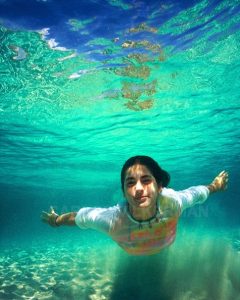ABOUT UNDERWATER CINEMATOGRAPHY

Photo by Underwater Cinematographer Carlos Vilkerman
Many times our scripts demand to shoot underwater. It is part of the story. Other times the allure of capturing the enchanting beauty and mysteries of the deep continues to inspire directors, producers, and screenplay writers worldwide. Advances in technology have made this enterprise easier, however, you need to have the right crew. The right underwater cinematographer is paramount. A cinematographer with vast experience, knowledgeable about the different environments, cameras, housings, lenses and support equipment is the difference between a successful and enjoyable shoot and disaster. For many years now, Carlos Vilkerman has paved the way for groundbreaking underwater cinematography.
Carlos Vilkerman thinks that the three-dimensional nature of the underwater world requires cinematographers and filmmakers to think spatially and consider the dynamics of movement in all directions. Crafting a compelling narrative underwater demands innovation in storytelling techniques and a deep understanding of the unique visual language of the aquatic realm.
However, shooting underwater comes with its own challenges. The difficulties of filming underwater are undeniable. One of the primary technical challenges in underwater filmmaking is the distortion of light and color underwater. Water absorbs and scatters light differently than air, causing a shift in colors. Refraction bends light depending on the salinity of the water or even the water temperature. Then we have visibility. Water turbidity can work in our favor or cancel the shoot when visibility is significantly reduced. Underwater cinematographers must contend with the loss of vibrant hues and adjust their equipment, often using specialized filters and lighting techniques to restore a natural and visually appealing aesthetic. Additionally, the need for waterproof cameras and or housings and specialized equipment adds complexity to the filmmaking process, as underwater gear must withstand pressure, moisture, and potential damage.
The logistics of underwater filmmaking present a myriad of difficulties. Access to suitable locations, pools deep enough, warm enough, big enough, and natural environment’s particularly those with clear water and diverse marine life which sometimes can be limiting. Transporting heavy equipment to remote underwater sites requires careful planning and can be prohibitively expensive. Underwater cinematographers must also consider the safety of their crew, addressing concerns such as diving certifications, emergency procedures, and the risks associated with extended periods underwater and depth. Coordinating a team of skilled divers, camera operators, and support staff is essential to executing a successful underwater shoot.
Lastly, when working exteriors, the underwater environment is dynamic and subject to unpredictable conditions. Currents, tides, and weather patterns can impact the visibility and safety of the shoot. Underwater cinematographers must be adaptable and prepared to make real-time adjustments to their plans. Additionally, the impact of human activity on underwater ecosystems poses ethical considerations. Responsible filmmaking involves minimizing disturbance to marine life and ecosystems, and adhering to ethical guidelines to preserve the delicate balance of underwater environments.
As filmmakers overcome technical, logistical, and creative challenges, the underwater world becomes a canvas for visual storytelling that captivates audiences and fosters a deeper appreciation for the wonders beneath the surface.
CARLOS VILKERMAN DECEMBER 2023